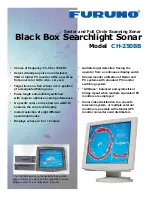
Versa Electronics
www.marcumtech.com
- 13 -
separate signals on your display. If you have a strike and fail to hook the fish,
you can even determine if you still have bait on your jig, or if you have to reel up
and re-bait based upon how the signal appears.
Dead Zone - All sonar units will have a dead zone in certain circumstances.
This occurs on sharp drop-offs where the transmit beam (cone) hits the shal-
lower edge of the drop-off and returns before the deeper edge returns. This in
effect creates an undisplayed area between the shallower and deeper water
within the transmit beam. The 8 degree transmit option on the LX-7 will greatly
reduce this effect.
How To Decide Which Configuration To Use
With 5 different sonar windows, along with a plethora of other settings, it can be
hard to decide on which one to display. If you have used traditional mechani-
cal flashers in the past, you may like the familiarity of the LX-7’s flasher display.
The flasher displayed with one or more of the vertical display is likely to be how
most anglers use the LX-7, at least for starters. We get endless feedback on
how well the scrolling graph display works for ice fishing, so be sure to give it a
try. Be sure to experiment with different color palettes and backgrounds, too.
CIRCULAR [FLASHER] DISPLAY— This Sonar window will read much like a
traditional flasher-style display. You can set the range manually, or allow the
Auto Range or Dynamic Depth Interface to automatically lock into a RANGE
that will optimize the use of the circular display. Signals are displayed as various
colored lines on the dial, and the different colors represent different signal
strengths.
VERTICAL DISPLAYS— These Sonar Portals are very easy to interpret—top
is the top, bottom is the bottom. Anything in between the top and bottom is
weeds, fish, or your lure. There are two different Vertical displays—one shows
the entire water column, one shows your ZOOM window. On each one, signals
are displayed as various colored lines on the column, and the different colors
represent different signal strengths.
SCROLLING GRAPH (CHART) DISPLAYS— These displays will show not
only what is happening below you in real time, but will also enable the user to
have a “history” of what has happened. While most commonly used for open
water, many anglers are discovering the benefits of using a graph on the ice.
The LX-7 stands apart from other graphs in that it displays with ultra-fast
“True-Time” sonar response – less than .02 seconds between the echo reaching
the transducer and when signal appears on LCD screen. Other graphs experi-
ence a much longer response time. When used from a boat in open water, the
user will see signals displayed in classic “Graph” fashion; the bottom will be a
solid band, and fish or other objects display as “arches”.
When used from a stationary position, such as ice fishing, the bottom will
display as a solid band, but other signals, like fish or your jig, will display as
lines of varying thickness. Always remember that the thicker the band, the
stronger the signal. A large fish is likely to display as a fairly thick band, while a























